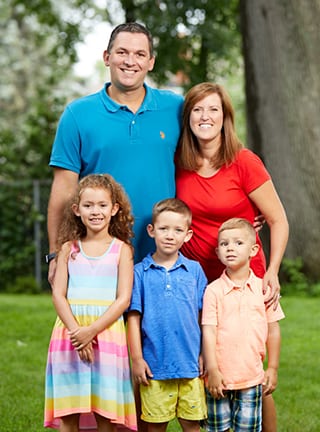How a Mother and Son With the Same Heart Condition Learned to Embrace Their Scars
After Cynthia Vander Molen’s son underwent open heart surgery, she wrote a book to help him and other children see how their scars make them stronger.
Cynthia Vander Molen vividly remembers the first time she worried about her health.
“I was 4 years old and playing in the sprinkler in my backyard in Hawthorne, New Jersey,” recalls the now 36-year-old high school history teacher and mother of three. “Facing open-heart surgery, I was hit with an overwhelming feeling of fear — something no child should have to go through.”
Cynthia’s mother likely felt that same fear when, shortly after birth, her daughter began turning blue.
“The doctors in New Jersey determined that it was my heart, and right away they sent me across the river to (what is now) NewYork-Presbyterian/Columbia University Irving Medical Center,” Cynthia recalls.
It turns out that she had a congenital heart defect known as tetralogy of Fallot [TOF]. Typically, patients with TOF are born with a combination of heart abnormalities that prevent blood from flowing normally throughout the body. In these patients, there is a hole between the two lower chambers of the heart and a narrowing of the passageway from the right ventricle into the pulmonary arteries — a condition known as pulmonary stenosis. Because of these two abnormalities, some of the oxygen-poor blood bypasses the lung and is pumped into the oxygen-rich side of the heart, causing the telltale blueish tinge that Cynthia developed as a newborn. About 5 in 10,000 babies in the U.S. are born with TOF each year, according to the National Institutes of Health.
“For the overwhelming majority of patients, it’s possible to repair the defects so they can lead a normal life,” says Dr. Marlon Rosenbaum, Cynthia’s cardiologist and director of the Schneeweiss Adult Congenital Heart Center at NewYork-Presbyterian/Columbia University Irving Medical Center. “But some cases are more complicated than others.”
Facing Surgery
Cynthia required multiple surgeries to increase the flow of oxygenated blood throughout her body, starting when she was 10 days old, followed by more operations, some of them experimental at the time.
“Growing up, I was constantly going in and out of New York City with my parents,” she says, “getting EKGs where they’d wire me up — it wasn’t easy.”
Yet after her open-heart surgery at age 4, Cynthia began to lead a normal life. While doctors cautioned against high-intensity sports like basketball or soccer, she played high school softball. She also developed a love for music.
“My sister was an athlete to the max, so I turned to the flute and piano,” Cynthia says.
She continued to make annual “checkup” trips to NewYork-Presbyterian/Columbia, where she met with Dr. Ehud Krongrad, her pediatric cardiologist.
“Talk to my mother about Dr. Krongrad and she’ll start crying. She feels so blessed that we found him,” Cynthia says.
Dr. Krongrad, an associate professor of pediatrics at Columbia University Vagelos College of Physicians and Surgeons, who retired when Cynthia was in college, recommended shortly before his retirement that she have a stent put into her left pulmonary artery to expand it and allow for more blood flow. The procedure was successful, so much so that nearly a decade later, at age 29, she and her husband, Dan, were eager to start a family.
They were concerned, however, about their children being born with TOF. According to Dr. Rosenbaum, there’s a 5 percent risk of passing down a congenital heart defect. That turned out to be a risk Cynthia and Dan were willing to take.

The Vander Molens today
“Most women with TOF and other congenital heart defects can become pregnant, but it’s important to evaluate them prior to conception so we can identify patients who would benefit from a revision before carrying a baby to term. Today we consider genetic risks and how best to optimize the heart for both mother and the developing baby,” says Dr. Rosenbaum.
After intense testing — a stress test to see how Cynthia’s heart could handle the strain of carrying a baby, along with an MRI scan of her heart, doctors gave the VanderMolens the green light. Their first child, “a beautiful girl we named Chloe,” was born in 2010, says Cynthia.
Given Chloe’s health at birth, Cynthia and Dan were utterly unprepared for what happened when she became pregnant again, two years later.
During her 20-week ultrasound, Cynthia realized that her New Jersey OB-GYN was taking an unusually long time with the exam.
“When they sent me to the cardiac unit,” says Cynthia, “I just knew what the issue was. Then the doctor said, ‘Well, it looks like we’ve got something here.’ I didn’t hear much after that. I was a mess.”
We never had any concern for his health because he was in such great hands.
Cynthia Vander Molen
Facing a Fraught Future
Because her pregnancy was now high-risk, Cynthia began seeing Dr. Russell Miller, a maternal fetal medicine expert at NewYork-Presbyterian/Columbia University Irving Medical Center and an associate professor of obstetrics and gynecology at Columbia University Vagelos College of Physicians and Surgeons, who specializes in handling such cases.
“We loved and adored him,” says Cynthia. “He was easygoing and comforting — a really great doctor to have in a horrible situation.”
Cynthia’s next step was to meet her specialized healthcare team. She and her husband met with a fetal cardiologist who laid out the health problems her baby, a boy, might face. This included DiGeorge syndrome, a chromosomal abnormality that can cause TOF and other serious mental and physical issues.
“It was extremely difficult to be told every possible scenario,” Cynthia recalls. Yet she also felt grateful for the knowledge, so that she and her doctors could be prepared for what might happen.
“It was a Catch-22,” she says. “On the one hand, I wasn’t going to be surprised, like my mother was when I turned blue. But I was also robbed of the joy of pregnancy. There was a constant cloud hanging over me.”

Jack and Cynthia play together in their backyard
A Team of Doctors at the Ready
The couple was also assigned a case manager who talked them “off the rails,” as Cynthia puts it. “She gave us her cellphone number and said we could call her anytime with questions. It was like having our own personal assistant at a time when we were totally overwhelmed.”
To further complicate matters, testing revealed that their baby would need immediate emergency surgery right after birth to ensure he was getting enough oxygen. Despite his relaxed manner, Dr. Miller sprang into action to get ready for what promised to be a difficult delivery.
The day of the delivery, Cynthia still recalls Dr. Miller cracking a joke to ease the tension and the kindness of the anesthesiologist who put an arm around her.
“They were all so comforting,” says Cynthia. “They knew that for me, the experience felt like a walk of doom.”
So when their son Jack was born pink and healthy, and in no need of immediate surgery, Cynthia and Dan were stunned, and thrilled.
“The doctor in the pediatric intensive care unit told us that had they not known about Jack’s condition beforehand,” Cynthia says, “they would have thought he was a totally normal baby. And so, we were able to push off the repair to a later time, which was just amazing news.”
Two Scars, Two Survivors
At 4 months, in April 2013, Jack needed heart surgery.
“That was a tough day,” says Cynthia. “You literally and physically have to hand your child over. But the nurses in the cardiac unit were angels. It was as if each one had multiple arms, because they were doing so many things at once. We never had any concern for his health because he was in such great hands.”
Jack’s surgery was performed by Dr. Jan M. Quaegebeur, a renowned pediatric cardiac surgeon at NewYork-Presbyterian Morgan Stanley Children’s Hospital and a professor of surgery at Columbia University Vagelos College of Physicians and Surgeons, who has since retired from the hospital. Though the surgery was successful and Jack had none of the other possible serious mental and physical issues, their dual medical journey was far from over.
Two years later, in 2015, Cynthia experienced an abnormal heart rhythm after the birth of her third child, a healthy boy named James.
Dr. Rosenbaum says patients who are born with congenital heart defects often need procedures throughout their lifetime. In Cynthia’s case, she had an enlarged right ventricle, which was affecting her stamina. Her condition necessitated a pulmonary valve replacement to reduce the strain on the right ventricle so it would eventually shrink.
“There can be subsequent issues patients aren’t always aware of when they’re younger, whether rhythm problems or an increased risk of heart failure,” says Dr. Rosenbaum, Cynthia’s cardiologist. “We don’t want to burden patients, but the message we try to convey is that conditions like tetralogy of Fallot require lifelong care. We want people to live fully, but to keep coming back so we can prevent problems before they become too difficult to correct.”
That was the case for Cynthia. “I always felt good physically, maybe because I didn’t know anything different, but now, I can actually go on jogs,” she says with enthusiasm. “I used to get winded just walking up stairs. Not anymore. The valve replacement made a major difference.”
Amazingly, it was Dr. Quaegebeur, who had operated on Jack just three years before, who also performed Cynthia’s valve replacement surgery.
Jack, now 5, is an empathetic first-grader who is always ready to offer a hug. Sometimes mother and son even compare the scars on their chests.
“Mine is red and bumpy but Jack’s is tiny — a very thin line you can barely see,” says Cynthia.
Yet Jack’s scar has played an outsized role in helping teach other children about heart conditions, and in forging a new path for Cynthia, who wrote a book, written in rhyme, called My Super Scar.
“The idea came to me one night when I was up late, rocking Jack back to sleep. It bothered me that when Jack was in the hospital for his surgery, there were no books to help young kids understand what it meant when another child was in need of surgery,” she recalls. “We wanted to be able to explain things to Chloe and her friends, to tell them why Jack had a scar on his chest. And I wanted Jack to know and other kids to know that this doesn’t have to be a burden — that it helps shape who you are.”
The book was published in 2017, and earlier this year, Cynthia and Jack went on a reading tour to local schools.
“I’d read the book, kids would ask questions, and Jack would show his scar,” she says. “I think he felt proud of it — it was his moment to show it off.”
Cynthia also writes a blog in an effort to provide help and support for parents of children facing serious medical issues.
Now, Jack goes once a year to see Dr. Zvi Marans, his pediatric cardiologist at NewYork-Presbyterian/Columbia University Irving Medical Center and an associate professor of pediatrics at Columbia University Vagelos College of Physicians and Surgeons.
“He knows Dr. Marans is his special heart doctor, the one that only he sees,” says Cynthia. “NewYork-Presbyterian/Columbia is interwoven into the fabric of who we are as a family. After everything we have been through, we are so thankful that we live so close to one of the greatest hospitals in the world. It truly has the best-of-the-best surgeons and doctors, who have always been so willing to provide the greatest care for myself and my son.”
To learn more about cardiac care, go to NYP.org/heart.
